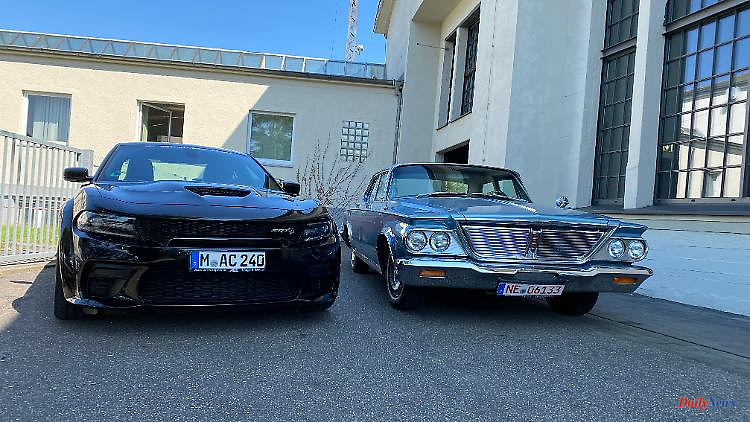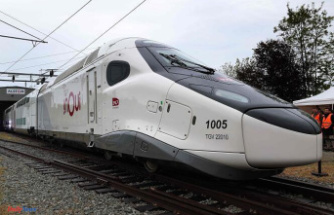Over the decades, the Chrysler Group has produced some exceptional limousines. The search for the historical model for the Dodge Charger Hellcat leads to a 1964 Chrysler New Yorker with a displacement of 6.8 liters. But the volume of the propellant is as similar as the character is different.
An indicator that we live in special times is when the new car no longer feels contemporary when comparing a current vehicle with a historic vehicle. The eight-cylinder will still be available for a number of years, but it is doubtful whether it will be in the form of the Charger Hellcat. A non-electrified displacement monster is raging there, and as if that weren't enough: the compressor also turns the six-point two into a performance monster. If you listen to Dodge boss Timothy Kuniskis, brute engine performance will continue to be Dodge's trademark. But it will almost certainly not come from an eight-cylinder. But let's put that fact aside for a moment and enjoy that you can still buy the Charger Hellcat.
Let's go back almost 60 years on the timeline. There were no US cars on the German market, large eight-cylinder engines were the rule overseas - small engines, on the other hand, were the exception. The comparison candidate for this text - a short-term available '64 Chrysler New Yorker, contributed by Auto SL from Düsseldorf, goes well with the infernal Charger with the addition Hellcat. However, the Charger does not have a consistent lineage, because the original Charger was a coupé.
The Chrysler New Yorker with a displacement of 6.8 liters is anything but ordinary in the American car cosmos of the 1960s. And so it is a suitable candidate to recreate the development of American sedans over the past few decades together with a current exceptional US car. Even if the eight-cylinder was certainly built in an inflationary manner in the land of almost unlimited automotive possibilities, most people are likely to have come to terms with displacements of less than six liters. And mobile pedestals with six pots were not exactly rare on the road either.
It quickly becomes clear which path the strong American four-door has taken: hand pressed to the skinny door handle and the button. The door opens, behind which a continuous, soft seat is mounted. The classic figure eight rumbles into a stable idle. And then it starts. It means listening to the big engine in peace and undisturbed and enjoying the boost from the low revs. Of course, the New Yorker is not a sporty car, to be honest, you even have trouble keeping the 5.47 meter long Ami on the road with the overly dedicated power steering.
The eye-catching giant blue liner with gold lettering lifts its nose as it pulls away energetically, as was and still is the case with the contemporary luxury liners from Crewe. The instruments, a mixture of large and small display scales, lack the rev counter. A gift, the 6.8 liter has so much power and doesn't have to rev up. He only does it reluctantly anyway. There are no shift breaks because the three-speed only changes the gear ratio once or twice. Overtaking is easy even with two thousand revs in high gear.
Time to focus on the current Dodge Charger. There really isn't much choice left when you're interested in an American eight-cylinder sedan. To be precise, you can only choose between the Cadillac CT5-V (not even available in this country) and the Dodge Charger - times are changing. The latter comes close to the classic upper class, at least in terms of its format with an external length of 5.11 meters. Despite a wheelbase of 3.05 meters, the Charger is by no means a miracle of space, but it's not cramped here either, except in the seat. The Charger chairs squeeze their passengers so tightly that they think they're in a racing car. Even the Hellcat version is nothing for sensitive tenths of a second hunts on complex tracks. The widely spaced axles slow down the predator's lateral performance.
Traffic light sprints or drag races - the Hellcat should be suitable for this, under four seconds to 100 km/h are set. But even that is not so easy because the 6.2-liter is actually too strong. Displacement may be irreplaceable, but when you add a supercharger, no tread pattern lasts long. The 305 Pirelli P-Zero placed under the widebody at the rear don't stand a chance when almost 900 Newton meters of torque attack them. Traction is a foreign word for the Charger, at least in the lower speed range.
Even a tiny movement of the gas pedal lets the Charger snap forward. Full load, on the other hand, generates a lot of smoke and little propulsion. The beast only gets its unbridled torque on the road beyond the 100 km/h mark. The Dodge is rather frugal with its upper class feeling, instead the engineers ensure tight sports sedan airs and graces. The V8 rumble is much more present here than in the New Yorker, with the exhaust flap open, the eighth roars so deafeningly that one should consider whether one dares to press the small silver-colored button for the exhaust control, bearing in mind possible police checks.
While performance is not important for the elderly New Yorker, despite the excess displacement, the largest currently available V8 US sedan in the second most powerful supercharged edition is a wild, untamed affair that effortlessly cracks the 300 km/h mark. The technicians have adapted the infotainment quite properly - there is a well-functioning navigation system that is also used in the Jeep products. In addition, the touchscreen is used to adjust many vehicle functions - including some drive parameters such as the switching strategy of the eight-speed automatic converter or the release of the full 707 horses. If you don't pay attention to this or use the wrong key, you will only drive with 500 hp.
Chrysler New Yorker and Dodge Charger are representative of the direction in which the basic character of the US V8 sedan has moved in the last 60 years. The "road cruisers" of the 1960s impress above all with their elegance, comfort and almost artistically designed, richly detailed interiors, while the remaining examples from 2022 have comparatively simple interiors, but are a sly old man under the hood. Your years are numbered. Downsizing and electrification will soon dominate. This will not detract from the driving performance, but some car enthusiasts will painfully miss the characteristic rumble.












